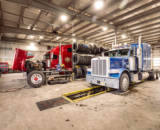/// Guest post by contributor Jon Scharingson, Renewable Energy Group
Making the move to biodiesel blends in your travel center or truck stop is a two-part process. In my last post, I walked through the paperwork process for fuel licenses, taxes and credit opportunities. Your next step is physically integrating the product into your retail diesel sales.
The U.S. biodiesel industry is expected to produce more than 1.3 billion gallons this year and high quality biodiesel availability is on the rise. Your locations can either purchase B100/B99 or a pre-blended product. Once you decide which route to go, you can learn more about the handling and storage requirements online.
1. Pre-Blended Purchases
Blends up to B5 (five percent biodiesel, 95 percent diesel) can be handled, stored and sold just as your diesel fuel would be. You can work with your current diesel provider to bring you a pre-blended fuel.
Once you move your blends up to B20, you should carefully review weather forecasts for your area and the regions to where your customers drive. Most pure biodiesel, B100, has a cloud point above that of No. 2 diesel which can create extra steps for blending when overnight temperatures dip.
For your customers, remember that in an operating engine, fuel can be used in temperatures below its cloud point.
2. Buying B100/B99 and Blending Onsite
For those with an additional storage tank or ability to install one, there are economic benefits for self-blending including access to state and federal incentives.
Recommended storage conditions depend almost entirely on your climate. Maintaining biodiesel’s temperature at least 10 F above its cloud point is critical to blending success. Above ground storage tanks with heat-tracing, below ground tanks or indoor tanks are great options for storing B100 and high blends in cold conditions.
To blend your biodiesel with diesel fuel, you can either splash blend or injection blend.
Splash Blending
- Biodiesel must be warm if diesel is cold
- Load order is important
- Top loading: load diesel then biodiesel
- Bottom loading: load biodiesel then diesel
In-Line (Injection) Blending
- Common at terminals
- Thorough mixing and consistent product
- Best option with cold diesel
- Allows “on demand” blending so your travel center can choose its blend based on daily economics
3. Buying B100 and Storing It Onsite
The biggest hurdle to successful biodiesel storage is keeping tanks clean and dry. When putting B100 into an existing tank it is important to clean the tank in advance because biodiesel can act as a cleaning agent to remove diesel residues and other substances from tank surfaces.
A good rule of thumb is to store your B100 or higher blends at about 70 degrees F.
4. Retail Pumps: No Infrastructure Changes Needed
Conventional diesel retail pumps can be used for any biodiesel blend up to B20. Higher blends can be dispensed safely as well, although hose selection should be considered for blends above B20. Some retailers choose to upgrade dispensers to offer customers a range of blends (a diesel/B5 nozzle, a B20 blend and a B50 blend, etc.).
Retailers should be aware of the labeling requirements to ensure FTC compliance.
Every travel center or truck stop can integrate a biodiesel blending program that best suits their operation and meets their customer needs. Our team at REG is happy to help walk through pricing, blending and storage information. The National Biodiesel Board also offers a wealth of information as you begin the integration process for offering high quality, clean burning biodiesel.
Editor's Note: In February, attendees at The NATSO Show 2013 had the opportunity to attend a NATSO U educational session on making biodiesel profitable at your travel plaza. NATSO and Chairman's Circle member Renewable Energy Group are partnering to offer the presentation again on June 6! NATSO members can register for this free webinar held Thursday, June 6 from 4 p.m. to 5 p.m. EDT. Attendees will learn about the status of the biodiesel industry and the 2013 outlook. They will get the latest updates regarding quality, the RFS2, federal and state legislation’s impact on positive blending opportunities and more.
/// Read more guest posts on biodiesel posts here.
{Guest Post} Guest post provided by NATSO Chairman's Circle member Jon Scharingson, Renewable Energy Group. Renewable Energy Group® is a leading North American biodiesel producer with a nationwide distribution and logistics system. With more than 210 million gallons of owned/operated annual production capacity at biorefineries across the country, REG is a proven biodiesel partner in the distillate marketplace. Learn more about Renewable Energy Group.
The opinions and advice given by guest post contributors are not necessarily those of NATSO Inc. The posts should not be considered legal advice. Qualified professionals should be sought regarding advice and questions specific to your circumstances.
Subscribe to Updates
NATSO provides a breadth of information created to strengthen travel plazas’ ability to meet the needs of the travelling public in an age of disruption. This includes knowledge filled blog posts, articles and publications. If you would like to receive a digest of blog post and articles directly in your inbox, please provide your name, email and the frequency of the updates you want to receive the email digest.

